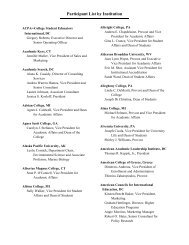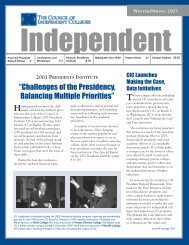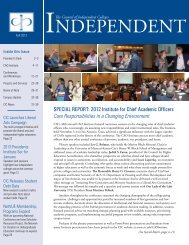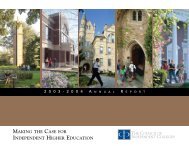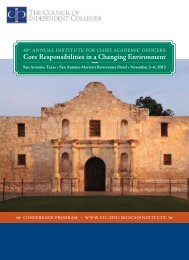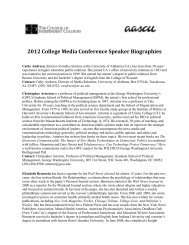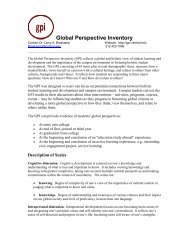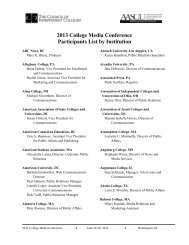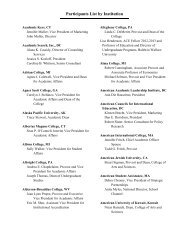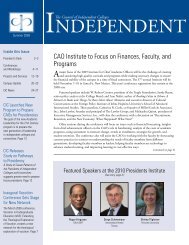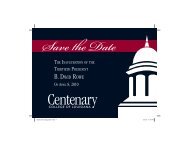Meeting the Challenge: - The Council of Independent Colleges
Meeting the Challenge: - The Council of Independent Colleges
Meeting the Challenge: - The Council of Independent Colleges
Create successful ePaper yourself
Turn your PDF publications into a flip-book with our unique Google optimized e-Paper software.
Small by Design: Resilience in an Era <strong>of</strong> Mass Higher Education<br />
Comparison <strong>of</strong> Student Enrollment to Bachelor's Degrees Conferred: 1981–2001<br />
100%<br />
80%<br />
79%<br />
60%<br />
63%<br />
40%<br />
37%<br />
20%<br />
21%<br />
0%<br />
Percentage <strong>of</strong> Student Enrollment<br />
Private<br />
Percentage <strong>of</strong> Degrees Conferred<br />
Public<br />
Source: U.S. Department <strong>of</strong> Education, National Center for Education Statistics<br />
American postsecondary education, liberal arts colleges<br />
were an attractive choice for veterans <strong>of</strong> World War II and<br />
later <strong>the</strong> Korean War. From 1945 to 1953 <strong>the</strong> small colleges<br />
welcomed student-veterans, rearranging facilities and courses<br />
to accommodate <strong>the</strong> influx <strong>of</strong> mature students.<br />
Although <strong>the</strong> bulge in enrollments from <strong>the</strong> GI<br />
Bill was temporary and started to subside by 1952, it did<br />
give trustees and leaders at liberal arts colleges a preview<br />
<strong>of</strong> changing demographics. Even with <strong>the</strong> unprecedented<br />
number <strong>of</strong> high school graduates who sought postsecondary<br />
education between 1945 and 1975, independent colleges<br />
still had to maintain <strong>the</strong>ir appeal by being distinctive and<br />
affordable. One partial solution to <strong>the</strong> national demand was<br />
for liberal arts colleges to increase <strong>the</strong> number <strong>of</strong> students<br />
<strong>the</strong>y admitted; institutions usually opted for careful, limited<br />
growth. Since massive expansion was not considered an<br />
educationally sound option, many liberal arts colleges now<br />
found that <strong>the</strong>y had more qualified applicants than <strong>the</strong>y<br />
could accept. For <strong>the</strong>se fortunate colleges <strong>the</strong> years from <strong>the</strong><br />
1950s to <strong>the</strong> 1970s became an era <strong>of</strong> selective admissions.<br />
Some liberal arts colleges began to carve out special niches<br />
in American higher education. <strong>The</strong>se were <strong>the</strong> schools that<br />
sociologist Burton Clark characterized as <strong>the</strong> “Distinctive<br />
<strong>Colleges</strong>,” a category that included such institutions as<br />
Swarthmore College in Pennsylvania, Antioch College in<br />
Ohio, and Reed College in Oregon.<br />
8



